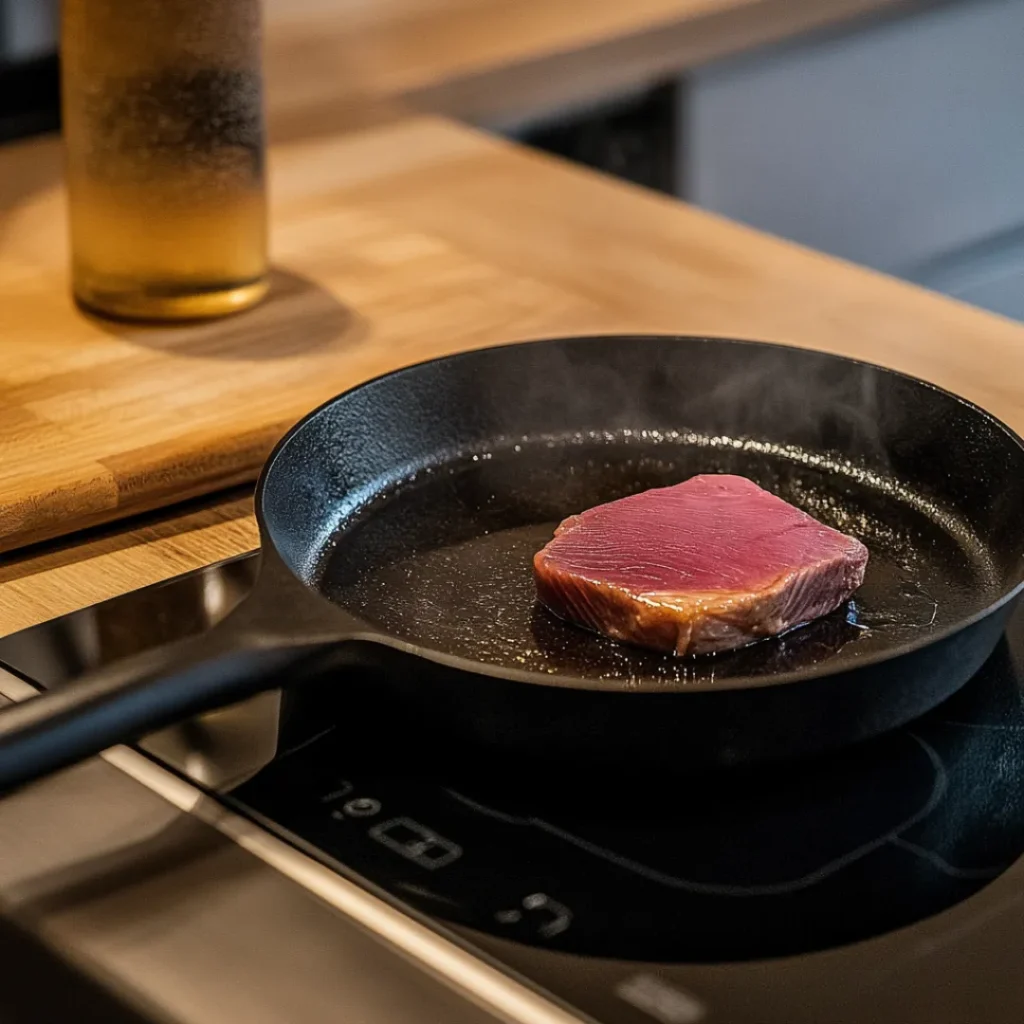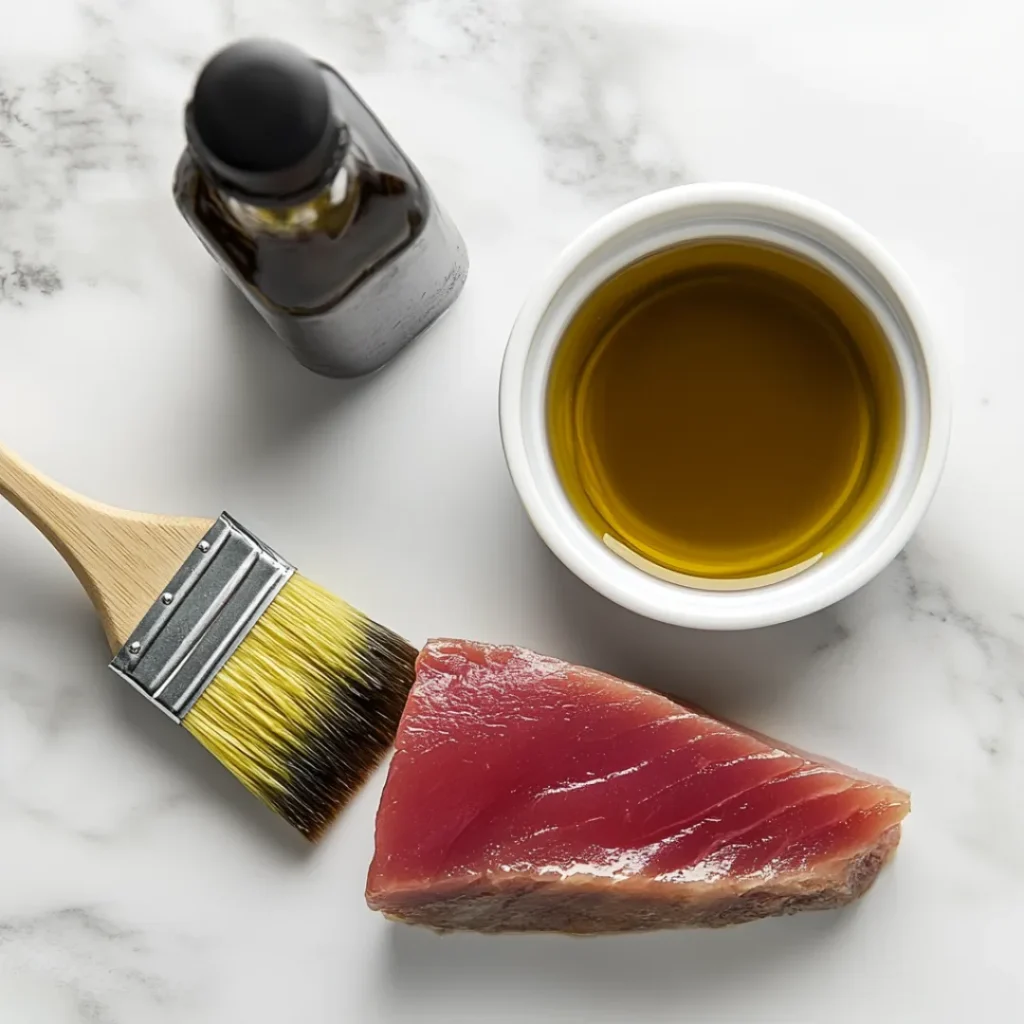Introduction to Searing Tuna In Butter
What is Searing and Why Does it Matter?
Is it better to sear tuna in butter or oillike some fancy technique reserved for Michelin-star chefs, but trust me—it’s simpler than you think. At its core, searing is all about cooking food over high heat to create a crispy, golden-brown crust. When it comes to tuna, this method locks in juices while giving the outside that irresistible crunch.
Table of Contents
Now, here’s where things get interesting. The fat you use—whether it’s butter or oil—plays a huge role in how your tuna turns out. You see, different fats bring different flavors and textures to the table. For example, butter adds richness, while oil often provides a cleaner taste. And let’s not forget about smoke points! If you crank up the heat too high, certain fats can burn faster than you can say “dinner’s ready.”
So yeah, choosing between butter and oil isn’t just about personal preference—it’s about understanding what works best for your dish.
Why Butter vs. Oil is a Key Debate
Let’s face it: the battle between butter and oil has been raging on for ages. Some folks swear by butter because, well, who doesn’t love that creamy, melt-in-your-mouth goodness? Others argue that oil is king, especially when you’re dealing with high temps.
When it comes to tuna, the stakes are even higher. After all, nobody wants their pricey piece of fish tasting burnt or greasy. That’s why answering the question—Is it better to sear tuna in butter or oil? —is so dang important. Stick around, and we’ll unpack the details so you can make the call yourself!
The Science Behind Searing Tuna

Understanding Heat Transfer in Cooking Fats
When it comes to searing tuna—or any protein, really—the type of fat you use makes a big difference. Why? Because fats don’t all behave the same way under heat. For instance, butter has a lower smoke point compared to most oils, which means it can burn more easily if the pan gets too hot. On the flip side, oils like avocado or grapeseed are champs at handling high temps without breaking a sweat.
So, what’s the deal with smoke points? Well, they’re basically the temperature at which a fat starts to break down and produce smoke. If you’ve ever burned butter while trying to cook, you know exactly what I’m talking about. That burnt smell? Yeah, not great for your dish. Therefore, when asking yourself, “Is it better to sear tuna in butter or oil?”, keep in mind that the cooking method matters just as much as the flavor.
Transitional phrase: With that said, if you’re aiming for a quick, high-heat sear, oil might be your best bet. But if you’re going for low-to-medium heat, butter could shine.
Butter’s Unique Flavor Profile
Let’s talk about why butter is so beloved in the kitchen. Honestly, there’s something magical about the rich, creamy taste it adds to food. When you sear tuna in butter, it coats the fish with a luxurious layer of flavor that oil just can’t replicate. Plus, butter helps create a beautiful golden crust that looks almost too good to eat—almost.
However—and this is a big however—butter’s lower smoke point means you gotta be careful. Crank up the heat too much, and you’ll end up with a smoky mess instead of a mouthwatering meal. This is why many home cooks wonder, “Is it better to sear tuna in butter or oil?” It’s all about balancing flavor with practicality.
Oil’s Versatility and High Smoke Point
Now, let’s give oils their moment in the spotlight. Unlike butter, oils like avocado, grapeseed, and refined olive oil have higher smoke points, making them perfect for high-heat cooking. They also tend to have neutral flavors, which lets the natural taste of the tuna take center stage.
In fact, if you’re someone who prefers simplicity over richness, oil might be your go-to. Just remember, though, that not all oils are created equal. Extra virgin olive oil, for example, has a lower smoke point, so it’s better suited for dressings than searing.
Pros and Cons of Using Butter to Sear Tuna

Advantages of Searing Tuna in Butter
Alright, butter fans, this one’s for you. There’s no denying that butter brings a level of decadence to seared tuna that’s hard to beat. First off, it adds an incredible depth of flavor that makes every bite feel special. Imagine sinking your teeth into a piece of tuna with a crispy, buttery crust—it’s like a hug for your taste buds!
Another perk? Butter helps achieve that picture-perfect golden sear. If you’re looking to impress dinner guests (or just yourself), butter’s ability to brown beautifully is a game-changer. And honestly, who doesn’t love the aroma of butter sizzling in a pan? It’s enough to make anyone’s stomach growl.
But here’s the kicker: butter isn’t just about flavor—it also contributes to texture. The creaminess it imparts can make the tuna feel richer and more indulgent. So, if you’re wondering, “Is it better to sear tuna in butter or oil?”, butter definitely has its charms.
Disadvantages of Using Butter
Of course, butter isn’t without its downsides. As we mentioned earlier, its lower smoke point can be a real headache. If you’re not careful, you might find yourself scrambling to open windows and turn on fans after burning the butter. Nobody wants that kind of drama in the kitchen!
Plus, butter can sometimes overpower the delicate flavor of tuna if you’re heavy-handed with it. While some people love the richness, others might find it a bit too much. It’s all about finding the right balance.
Tips for Preventing Butter from Burning

Luckily, there are ways to enjoy the best of both worlds. One trick is to use clarified butter, also known as ghee. Ghee has a higher smoke point than regular butter, which means you can crank up the heat without worrying about burning. Another option is to combine butter with a splash of oil. This mix gives you the flavor of butter while borrowing the heat resistance of oil.
Pro tip: Keep an eye on the pan and adjust the heat as needed. A little patience goes a long way when working with butter.
Internal Link: How to Make Clarified Butter at Home
Pros and Cons of Using Oil to Sear Tuna
Advantages of Searing Tuna in Oil
Alright, oil enthusiasts, let’s give this kitchen staple its due credit. When it comes to searing tuna, oil has a lot going for it. For starters, most cooking oils have higher smoke points than butter, which makes them ideal for high-heat cooking. This means you can crank up the heat without worrying about burning your fat—or ruining your dish.
Another big win for oil? Its neutral flavor. Unlike butter, which adds richness, oils like avocado or grapeseed let the natural taste of the tuna shine through. If you’re someone who loves the pure, ocean-fresh flavor of tuna, oil is your best friend. Plus, these oils are often healthier options, especially if you’re watching your saturated fat intake.
And here’s a bonus: oil spreads evenly across the pan, creating a consistent sear that’s hard to mess up. So, when you’re asking yourself, “Is it better to sear tuna in butter or oil?”, oil might just take the crown for practicality and ease.
Disadvantages of Using Oil
Now, don’t get me wrong—oil isn’t perfect either. One downside is that it lacks the rich, indulgent flavor butter brings to the table. Sure, it gets the job done, but some folks find oil-seared tuna a bit… plain. It’s kind of like choosing a plain bagel over one slathered with cream cheese—you miss out on that extra layer of yumminess.
Another thing to consider is the type of oil you use. Not all oils are created equal, and some can leave a slightly greasy aftertaste if you’re not careful. For example, using too much oil or picking the wrong kind can make your tuna feel heavy instead of light and fresh.
Best Oils for Searing Tuna
If you decide to go the oil route, you’ve got plenty of great options. Avocado oil is a top pick because of its super-high smoke point and mild flavor. Grapeseed oil is another excellent choice—it’s affordable, versatile, and works beautifully for searing. Refined olive oil also gets a thumbs-up, though you’ll wanna skip extra virgin olive oil since it burns easily.
Pro tip: Experiment with flavored oils, like chili-infused or garlic-infused, to add a little zing to your tuna. Just a drizzle can transform a simple dish into something special.
Internal Link: Top 5 Healthiest Cooking Oils for High-Heat Cooking
Expert Opinions and Popular Techniques
What Do Professional Chefs Recommend?
So, what do the pros say about the age-old debate: “Is it better to sear tuna in butter or oil?” Turns out, opinions vary depending on the chef’s style and the dish they’re making. Some chefs swear by butter for its unmatched flavor, while others lean toward oil for its versatility and reliability.
For instance, Chef Gordon Ramsay often uses clarified butter (ghee) for searing fish because it combines the best of both worlds—rich flavor and a higher smoke point. Meanwhile, Chef Jamie Oliver tends to favor neutral oils like olive or sunflower for their simplicity and health benefits.
What’s clear is that there’s no one-size-fits-all answer. The choice ultimately depends on your personal taste and how you plan to cook the tuna.
Popular Recipes That Use Butter or Oil
Let’s take a look at some popular recipes to see how butter and oil are used in real-world dishes. For example, many Asian-inspired tuna recipes rely on sesame oil for its nutty aroma and high smoke point. On the other hand, French-style tuna dishes often feature butter to create a luxurious, restaurant-quality finish.
One fan-favorite recipe involves searing tuna in a mix of butter and olive oil, then finishing it with a squeeze of lemon and fresh herbs. It’s quick, easy, and packed with flavor—perfect for busy weeknights or fancy dinner parties.
Pro tip: If you’re unsure which fat to use, try combining them! A little butter mixed with oil gives you the best of both worlds: flavor and heat resistance.
Why Technique Matters More Than Fat Choice
Here’s the truth: whether you choose butter or oil, technique matters more than anything else. Make sure your pan is hot before adding the tuna, season generously, and don’t overcrowd the pan. These small steps can make a huge difference in the final result.
For more delicious recipes, check out our recipe article: Master Chef’s Guide to Perfectly Seared Tuna
Step-by-Step Guide to Searing Tuna Words)
How to Sear Tuna in Butter
Alright, butter lovers, let’s get down to business. If you’ve decided that butter is your fat of choice, here’s how to sear tuna like a pro without burning the house down. First things first, grab a heavy-bottomed skillet and heat it over medium heat. You don’t want the pan too hot—remember, butter has a lower smoke point, so cranking the heat will only lead to disaster.
Once the pan is warm, add a tablespoon or two of butter. Let it melt and start to foam slightly before adding your tuna. Pro tip: pat the tuna dry with paper towels before seasoning it with salt, pepper, and any other spices you fancy. A dry surface ensures a crispy crust, while the seasoning adds an extra layer of flavor.
Now, gently place the tuna in the pan and let it cook undisturbed for about 1-2 minutes per side, depending on how thick the steak is. Keep an eye on the butter—if it starts to brown too quickly, lower the heat. Once both sides are beautifully golden, remove the tuna and let it rest for a minute before slicing. Voilà! You’ve just nailed the butter-seared tuna technique.
Internal Link: How to Make Clarified Butter at Home
How to Sear Tuna in Oil
If you’re team oil, this method is for you. Start by heating a neutral oil, like avocado or grapeseed, in a skillet over medium-high heat. The key here is to let the oil get nice and hot before adding the tuna—this ensures a killer sear.
Just like with butter, make sure your tuna is patted dry and generously seasoned. Carefully place the tuna in the pan and let it cook for about 1-2 minutes per side. Since oil can handle higher temps, you might notice a slightly darker crust compared to butter. That’s a good thing—it means more flavor!
Once the tuna is seared to perfection, transfer it to a plate and let it rest for a minute. This step is crucial because it allows the juices to redistribute, keeping the fish tender and juicy. Pair it with a squeeze of lemon or a drizzle of sauce, and you’re ready to impress.
Internal Link: Ultimate Seasoning Guide for Fish Dishes
FAQs Based on ‘People Also Ask’ Section
Can You Mix Butter and Oil When Searing Tuna?
Absolutely! In fact, mixing butter and oil is one of the smartest moves you can make. The oil helps raise the overall smoke point, while the butter adds that rich, creamy flavor we all love. It’s like having your cake and eating it too—literally.
Which Oil is Best for Pan-Seared Tuna?
When it comes to oils, avocado oil and grapeseed oil are top contenders. Both have high smoke points and neutral flavors, making them perfect for searing tuna without overpowering its natural taste. Refined olive oil works well too, but steer clear of extra virgin olive oil—it’s not cut out for high heat.
Does Searing Tuna in Butter Make It Unhealthy?
Not necessarily. While butter does contain saturated fats, using it in moderation won’t hurt. Plus, the flavor boost it gives your dish might just make you happier—and happiness counts for something, right? If you’re watching your intake, clarified butter (ghee) is a slightly healthier alternative.
How Long Should You Sear Tuna?
Here’s the golden rule: less is more. Tuna is best when it’s still pink in the middle, so aim for 1-2 minutes per side, depending on thickness. Overcooking will turn it dry and chewy, which nobody wants.
What Temperature Should the Pan Be?
For butter, keep the pan at medium heat to avoid burning. For oil, crank it up to medium-high to achieve that perfect sear. Remember, the pan should be hot enough to sizzle as soon as the tuna hits it.

